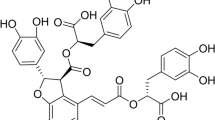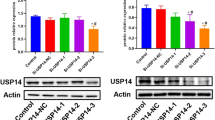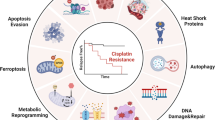Abstract
Gemcitabine is commonly used to treat various cancer types, including human non-small cell lung cancer (NSCLC). However, even cases that initially respond rapidly commonly develop acquired resistance, limiting our ability to effectively treat advanced NSCLC. To gain insight for developing a strategy to overcome gemcitabine resistance, the present study investigated the mechanism of gemcitabine resistance in NSCLC according to the involvement of ATP-binding cassette subfamily B member 6 (ABCB6) and heme biosynthesis. First, an analysis of ABCB6 expression in human NSCLCs was found to be associated with poor prognosis and gemcitabine resistance in a hypoxia-inducible factor (HIF)-1-dependent manner. Further experiments showed that activation of HIF-1α/ABCB6 signaling led to intracellular heme metabolic reprogramming and a corresponding increase in heme biosynthesis to enhance the activation and accumulation of catalase. Increased catalase levels diminished the effective levels of reactive oxygen species, thereby promoting gemcitabine-based resistance. In a mouse NSCLC model, inhibition of HIF-1α or ABCB6, in combination with gemcitabine, strongly restrained tumor proliferation, increased tumor cell apoptosis, and prolonged animal survival. These results suggest that, in combination with gemcitabine-based chemotherapy, targeting HIF-1α/ABCB6 signaling could result in enhanced tumor chemosensitivity and, thus, may improve outcomes in NSCLC patients.







Similar content being viewed by others
Data availability
All data generated or analyzed during this study are included in this article.
References
Torre LA et al (2015) Global cancer statistics, 2012. CA Cancer J Clin 65(2):87–108
Ferlay J et al (2015) Cancer incidence and mortality worldwide: sources, methods and major patterns in GLOBOCAN 2012. Int J Cancer 136(5):E359–E386
Gao P et al (2018) miR-3607-3p suppresses non-small cell lung cancer (NSCLC) by targeting TGFBR1 and CCNE2. PLoS Genet 14(12):e1007790
Jemal A et al (2010) Cancer statistics, 2010. CA Cancer J Clin 60(5):277–300
Hirsch FR et al (2017) Lung cancer: current therapies and new targeted treatments. Lancet 389(10066):299–311
Mini E et al (2006) Cellular pharmacology of gemcitabine. Ann Oncol 17(Suppl 5):v7-12
Toschi L et al (2005) Role of gemcitabine in cancer therapy. Future Oncol 1(1):7–17
Hlavata I et al (2012) The role of ABC transporters in progression and clinical outcome of colorectal cancer. Mutagenesis 27(2):187–196
Cole SP et al (1992) Overexpression of a transporter gene in a multidrug-resistant human lung cancer cell line. Science 258(5088):1650–1654
Krishnamurthy PC et al (2006) Identification of a mammalian mitochondrial porphyrin transporter. Nature 443(7111):586–589
Boswell-Casteel RC, Fukuda Y, Schuetz JD (2017) ABCB6, an ABC transporter impacting drug response and disease. Aaps J 20(1):8
Lee JW et al (2004) Hypoxia-inducible factor (HIF-1)alpha: its protein stability and biological functions. Exp Mol Med 36(1):1–12
Lu H et al (2015) Chemotherapy triggers HIF-1-dependent glutathione synthesis and copper chelation that induces the breast cancer stem cell phenotype. Proc Natl Acad Sci U S A 112(33):E4600–E4609
Kim WY et al (2009) Targeting heat shock protein 90 overrides the resistance of lung cancer cells by blocking radiation-induced stabilization of hypoxia-inducible factor-1alpha. Cancer Res 69(4):1624–1632
Nantapong N et al (2019) The effect of reactive oxygen species (ROS) and ROS-scavenging enzymes, superoxide dismutase and catalase, on the thermotolerant ability of Corynebacterium glutamicum. Appl Microbiol Biotechnol 103(13):5355–5366
Goyal MM, Basak A (2010) Human catalase: looking for complete identity. Protein Cell 1(10):888–897
Sichak SP, Dounce AL (1986) Analysis of the peroxidatic mode of action of catalase. Arch Biochem Biophys 249(2):286–295
Gyorffy B et al (2013) Online survival analysis software to assess the prognostic value of biomarkers using transcriptomic data in non-small-cell lung cancer. PLoS ONE 8(12):e82241
Xiang L et al (2019) Glutaminase 1 expression in colorectal cancer cells is induced by hypoxia and required for tumor growth, invasion, and metastatic colonization. Cell Death Dis 10(2):40
Xiang L et al (2014) Hypoxia-inducible factor 1 mediates TAZ expression and nuclear localization to induce the breast cancer stem cell phenotype. Oncotarget 5(24):12509–12527
Zhang H et al (2012) HIF-1-dependent expression of angiopoietin-like 4 and L1CAM mediates vascular metastasis of hypoxic breast cancer cells to the lungs. Oncogene 31(14):1757–1770
Sassa S, Kappas A (1977) Induction of aminolevulinate synthase and porphyrins in cultured liver cells maintained in chemically defined medium. Permissive effects of hormones on induction process. J Biol Chem 252(7):2428–2436
Xiang L et al (2014) Ganetespib blocks HIF-1 activity and inhibits tumor growth, vascularization, stem cell maintenance, invasion, and metastasis in orthotopic mouse models of triple-negative breast cancer. J Mol Med (Berl) 92(2):151–164
Benda JA, Zaino R (1994) GOG pathology manual: gynecologic oncology group. Buffalo, NY
Nagy A et al (2018) Validation of miRNA prognostic power in hepatocellular carcinoma using expression data of independent datasets. Sci Rep 8(1):9227
Bogomolova AM et al (2019) Hypoxia as a factor involved in the regulation of the apoA-1, ABCA1, and complement C3 gene expression in human macrophages. Biochemistry (Mosc) 84(5):529–539
Plosch T et al (2010) The liver X receptor (LXR) and its target gene ABCA1 are regulated upon low oxygen in human trophoblast cells: a reason for alterations in preeclampsia? Placenta 31(10):910–918
Chou CW et al (2012) Tumor cycling hypoxia induces chemoresistance in glioblastoma multiforme by upregulating the expression and function of ABCB1. Neuro Oncol 14(10):1227–1238
He X et al (2016) Hypoxia regulates ABCG2 activity through the activation of ERK1/2/HIF-1alpha and contributes to chemoresistance in pancreatic cancer cells. Cancer Biol Ther 17(2):188–198
Albadari N, Deng S, Li W (2019) The transcriptional factors HIF-1 and HIF-2 and their novel inhibitors in cancer therapy. Expert Opin Drug Discov 14(7):667–682
Shukla SK et al (2017) MUC1 and HIF-1alpha signaling crosstalk induces anabolic glucose metabolism to impart gemcitabine resistance to pancreatic cancer. Cancer Cell 32(1):71-87.e7
Coulet F et al (2003) Identification of hypoxia-response element in the human endothelial nitric-oxide synthase gene promoter. J Biol Chem 278(47):46230–46240
Elks PM et al (2015) Exploring the HIFs, buts and maybes of hypoxia signalling in disease: lessons from zebrafish models. Dis Model Mech 8(11):1349–1360
Bhattarai D, Xu X, Lee K (2018) Hypoxia-inducible factor-1 (HIF-1) inhibitors from the last decade (2007 to 2016): a “structure-activity relationship” perspective. Med Res Rev 38(4):1404–1442
Kimura H (2013) Histone modifications for human epigenome analysis. J Hum Genet 58(7):439–445
Krishnamurthy P, Xie T, Schuetz JD (2007) The role of transporters in cellular heme and porphyrin homeostasis. Pharmacol Ther 114(3):345–358
Chiabrando D et al (2014) Heme in pathophysiology: a matter of scavenging, metabolism and trafficking across cell membranes. Front Pharmacol 5:61
Sohoni S et al (2019) Elevated heme synthesis and uptake underpin intensified oxidative metabolism and tumorigenic functions in non-small cell lung cancer cells. Cancer Res 79(10):2511–2525
Kumar J et al (2019) Nutraceutical profile and evidence of alleviation of oxidative stress by Spirogyra porticalis (Muell.) Cleve inhabiting the high altitude Trans-Himalayan Region. Sci Rep 9(1):4091
Dyle MC et al (2014) Systems-based discovery of tomatidine as a natural small molecule inhibitor of skeletal muscle atrophy. J Biol Chem 289(21):14913–14924
Chiu FL, Lin JK (2008) Tomatidine inhibits iNOS and COX-2 through suppression of NF-kappaB and JNK pathways in LPS-stimulated mouse macrophages. FEBS Lett 582(16):2407–2412
Vestergaard M, Roshanak S, Ingmer H (2021) Targeting the ATP synthase in Staphylococcus aureus small colony variants, Streptococcus pyogenes and pathogenic fungi. Antibiotics (Basel) 10(4):376
Lavie Y et al (2001) Inhibitory effect of steroidal alkaloids on drug transport and multidrug resistance in human cancer cells. Anticancer Res 21(2a):1189–1194
de Sousa Cavalcante L, Monteiro G (2014) Gemcitabine: metabolism and molecular mechanisms of action, sensitivity and chemoresistance in pancreatic cancer. Eur J Pharmacol 741:8–16
Gebregiworgis T et al (2018) Insights into gemcitabine resistance and the potential for therapeutic monitoring. Metabolomics 14(12):156
Hu J et al (2015) Effect of ceritinib (LDK378) on enhancement of chemotherapeutic agents in ABCB1 and ABCG2 overexpressing cells in vitro and in vivo. Oncotarget 6(42):44643–44659
Manoochehri Khoshinani H, Afshar S, Najafi R (2016) Hypoxia: a double-edged sword in cancer therapy. Cancer Invest 34(10):536–545
O’Donnell JL et al (2006) Oncological implications of hypoxia inducible factor-1alpha (HIF-1alpha) expression. Cancer Treat Rev 32(6):407–416
Chaika NV et al (2012) MUC1 mucin stabilizes and activates hypoxia-inducible factor 1 alpha to regulate metabolism in pancreatic cancer. Proc Natl Acad Sci USA 109(34):13787–13792
Bosc C, Selak MA, Sarry JE (2017) Resistance is futile: targeting mitochondrial energetics and metabolism to overcome drug resistance in cancer treatment. Cell Metab 26(5):705–707
Nagao A et al (2019) HIF-1-dependent reprogramming of glucose metabolic pathway of cancer cells and its therapeutic significance. Int J Mol Sci 20(2):238
Zhang B et al (2020) Regulation of branched-chain amino acid metabolism by hypoxia-inducible factor in glioblastoma. Cell Mol Life Sci 78:195–206
Wu J et al (2015) HIF-1α in the heart: remodeling nucleotide metabolism. J Mol Cell Cardiol 82:194–200
Mylonis I, Simos G, Paraskeva E (2019) Hypoxia-inducible factors and the regulation of lipid metabolism. Cells 8(3):214
Xiang L et al (2013) Knock-down of glutaminase 2 expression decreases glutathione, NADH, and sensitizes cervical cancer to ionizing radiation. Biochim Biophys Acta 1833(12):2996–3005
Yao X et al (2010) Heme controls the regulation of protein tyrosine kinases Jak2 and Src. Biochem Biophys Res Commun 403(1):30–35
Quick-Cleveland J et al (2014) The DGCR8 RNA-binding heme domain recognizes primary microRNAs by clamping the hairpin. Cell Rep 7(6):1994–2005
Paz-Ares L et al (2006) Phase III study of gemcitabine and cisplatin with or without aprinocarsen, a protein kinase C-alpha antisense oligonucleotide, in patients with advanced-stage non-small-cell lung cancer. J Clin Oncol 24(9):1428–1434
Heinemann V et al (2006) Randomized phase III trial of gemcitabine plus cisplatin compared with gemcitabine alone in advanced pancreatic cancer. J Clin Oncol 24(24):3946–3952
Zhou C et al (2011) Erlotinib versus chemotherapy as first-line treatment for patients with advanced EGFR mutation-positive non-small-cell lung cancer (OPTIMAL, CTONG-0802): a multicentre, open-label, randomised, phase 3 study. Lancet Oncol 12(8):735–742
Bello L et al (2001) Low-dose chemotherapy combined with an antiangiogenic drug reduces human glioma growth in vivo. Cancer Res 61(20):7501–7506
Tallón de Lara P et al (2018) Gemcitabine synergizes with immune checkpoint inhibitors and overcomes resistance in a preclinical model and mesothelioma patients. Clin Cancer Res 24(24):6345–6354
Raykov Z et al (2014) Myo-inositol trispyrophosphate-mediated hypoxia reversion controls pancreatic cancer in rodents and enhances gemcitabine efficacy. Int J Cancer 134(11):2572–2582
Gstalder C, Ader I, Cuvillier O (2016) FTY720 (Fingolimod) inhibits HIF1 and HIF2 signaling, promotes vascular remodeling, and chemosensitizes in renal cell carcinoma animal model. Mol Cancer Ther 15(10):2465–2474
Zhao T et al (2015) Inhibition of HIF-1α by PX-478 enhances the anti-tumor effect of gemcitabine by inducing immunogenic cell death in pancreatic ductal adenocarcinoma. Oncotarget 6(4):2250–2262
Acknowledgements
We gratefully acknowledge Dr. Feng Wu and Dr. Yong Lin from the Department of Pathophysiology, Third Military Medical University for their kind help in assessing IHC results.
Funding
This work was supported by the Sichuan Science and Technology Program (2020YJ0046, 2020YFS0272 and 2019YJ0041), the Natural Science Foundation of Chongqing (cstc2018jcyjAX0512 and cstc2019jcyj-msxmX0791), and the National Science and Technology Major Project (2017ZX09304023).
Author information
Authors and Affiliations
Contributions
LX, BS and GX designed the study and wrote the paper. LX, GX, JL and FN performed the experiments. LX, SW, YG and HD analyzed the data. BS and GX advised on experimental procedures and revision of the paper. YW revised the paper. All the authors contributed to this manuscript. All the authors read and approved the final manuscript.
Corresponding authors
Ethics declarations
Conflict of interest
The authors declare that they have no competing interests.
Ethics approval and consent to participate
The experimental protocol was established according to the ethical guidelines of the 1964 Declaration of Helsinki. The protocol for IHC staining of patient tissues was approved by the Ethics Committee of the First Affiliated Hospital (Southwest Hospital), the Third Military Medical University (Army Medical University), and all patients or family members involved provided written informed consent.
Consent for publication
Written informed consent for publication was obtained from all participants.
Additional information
Publisher's Note
Springer Nature remains neutral with regard to jurisdictional claims in published maps and institutional affiliations.
Supplementary Information
Below is the link to the electronic supplementary material.
Figure S1.
Establishment of gemcitabine-resistant (GR) NSCLC cell lines. A549 lung adenocarcinoma and H1703 lung squamous cell carcinoma cell lines with acquired gemcitabine resistance were generated by exposing the corresponding wild-type (WT) cells to increasing concentrations of gemcitabine over 7 months. The resistance status was confirmed by cell viability assays and soft agar assays at each step. A-B, NSCLC cells were treated with gemcitabine for 72 h, and cell viability was analyzed using MTS. The viability of A549-WT (A) and H1703-WT (B) cells was respectively suppressed compared to A549-GR (A) and H1703-GR (B) cells upon treatment with gemcitabine in a dosedependent manner. Images of the colonies formed from A549-GR (A) and H1703-GR (B) cells as compared to relevant WT cells treated with 0.5 or 1 μM gemcitabine (as indicated) for 72 h and cultured for 15 days. C-D, Average colony number (C) and colony size (D) for A549-GR cells compared to A549-WT cells, as determined by soft agar assays. E-F, Average colony number (E) and colony size (F) for H1703-GR cells compared to H1703-WT cells. Colony number and size were determined by pictomicrography. The results shown are the average values from three independent experiments (mean±SEM; n=3). Student’s t-test was used to determine the P value, ***P<0.0001. (TIF 1408 KB)
Figure S2.
mRNA expression of genes in the ABC family in A549 subgroups. RT-qPCR was performed to quantify mRNA levels of genes from the ABC family (A, ABCA1; B, ABCA2; C, ABCB1; D, ABCB2; E, ABCB3; F, ABCB6; G, ABCC3; H, ABCC5; I, ABCG2) in A549-WT versus A549-GR cells, and in A549-WT cells exposed to hypoxia (1% O2) for 24 h. For each sample, gene mRNA expression was quantified relative to 18S rRNA and then normalized to the result obtained from WT cells. Statistical analysis was performed before normalization (mean±SEM; n=3). *P<0.05, ***P<0.001 vs. WT cells (Student’s t test). (TIF 1163 KB)
Figure S3.
HIF-binding sites 1 and 2 in the ABCB6 gene. Two sequences (1 and 2) matching the consensus 5′-RCGTG-3′ (R = A or G; shown in red) and located in a DNase I hypersensitive region of chromatin (coordinates given relative to the transcription start site) were tested for binding of HIF-1α and HIF-1β by ChIP assay. HIF-1 was shown to bind selectively to sites 1 and 2 (see Figure 4 and Figure S3C-S3F). H3K4Me1 and H3K4Me3, monomethylation and trimethylation, respectively, of lysine residue 4 of histone H3; H3K27Ac, acetylation of lysine-27 of histone H3. (TIF 1792 KB)
Figure S4.
A, Protein expression levels of HIF-1α and ABCB6 in A549-GR subclones transfected with lentiviral vectors encoding shRNA targeting ABCB6 (shABCB6-1, shABCB6-2), shRNAs targeting both HIF-1α and ABCB6 (sh1α/ABCB6) and non-targeting control (NTC). B, Protein levels of HIF-1α and ABCB6 in H1703-GR subclones transfected with lentiviral vectors encoding shRNA targeting ABCB6 (shABCB6-1, shABCB6-2), shRNAs targeting both HIF-1α and ABCB6 (sh1α/ABCB6) and NTC. C-F, Two HIF-binding sites (HRE site 1 and HRE site 2) of the human ABCB6 gene were identified by ChIP assay as described below. ChIP assays were performed using IgG or antibodies against HIF-1α, HIF-1β and HIF-2α in H1703-WT and H1703-GR cells (C, site 1; E, site 2), and H1703-WT cells under normoxic or hypoxic conditions (D, site 1; F, site 2). Primers flanking the HRE site were used for qPCR, and results were normalized to lane 1 (mean±SEM; n=3). ***P<0.001 vs. WT or normoxia (ANOVA with Bonferroni post-test). (TIF 1005 KB)
Figure
S6. A549 NTC, shHIF-1α, shABCB6 subclones (2×106 cells) were implanted into the groin of 6-to 8-week-old male SCID mice. After palpable tumors had formed (26 days after tumor implantation), mice received intraperitoneal injection of gemcitabine (20 mg/kg) or saline (250 µl) twice per week until day 53. A, Volume of primary tumors formed by A549 subclones treated with gemcitabine or saline, as determined twice weekly. **P<0.01, ***P<0.001 vs. NTC + saline by two-way ANOVA with Bonferroni post-test (mean±SEM; n=5). B, Representative images of tumors in A549 subgroups. (TIF 1706 KB)
Rights and permissions
About this article
Cite this article
Xiang, L., Wang, Y., Lan, J. et al. HIF-1-dependent heme synthesis promotes gemcitabine resistance in human non-small cell lung cancers via enhanced ABCB6 expression. Cell. Mol. Life Sci. 79, 343 (2022). https://doi.org/10.1007/s00018-022-04360-9
Received:
Revised:
Accepted:
Published:
DOI: https://doi.org/10.1007/s00018-022-04360-9




